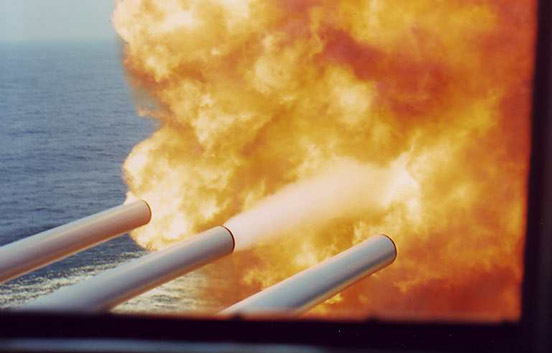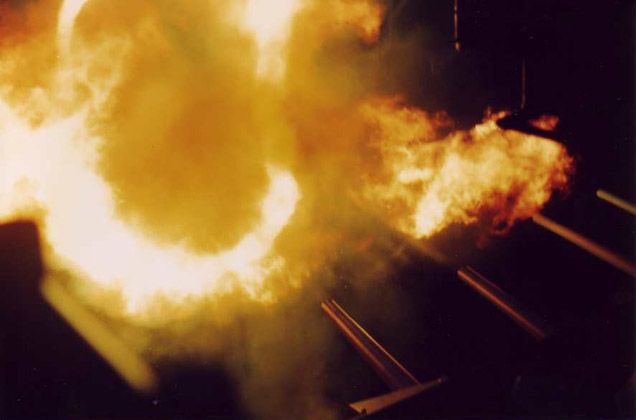

Posted on 09/18/2006 7:41:46 PM PDT by neverdem
On Dec. 4, 1983, 28 aircraft from the USS Independence Carrier Battle Group attacked Hezbollah and Syrian anti-aircraft positions in Lebanon's Bekaa Valley. Two U.S. Navy A-7s were lost on the mission and a third aircraft was damaged. One of the downed pilots died of wounds in captivity and the other, Lt. Robert Goodman, was taken prisoner and paraded before the cameras. Though Lt. Goodman was eventually released, the U.S. Navy had learned a hard lesson.
Ten days later, U.S. reconnaissance flights were fired on again -- but this time the response was different. Instead of launching air strikes, the battleship USS New Jersey opened fire -- and with just 11 2,700-pound, 16-inch rounds, silenced the anti-aircraft sites. This feat was repeated on Feb. 8, 1984, when Syrian artillery opened fire on Christian West Beirut -- inflicting heavy civilian casualties. Less than two hours of fire from the New Jersey's 16-inch guns eliminated the Syrian artillery threat. It wouldn't be the last time the World War II-era "battlewagons" would serve our national interests.
During the 1981-1988 Iran-Iraq War, the Ayatollahs running Tehran decided the best way to influence the outcome of the conflict was to attack Western oil tankers transiting the Persian Gulf -- through which passes 20 percent of the world's oil. The United States responded by beefing up the 5th Fleet -- and deploying the USS Iowa. The battleship's captain, Larry Sequist, described the effectiveness of the 45,000-ton armored behemoth: "When we would sail the Iowa down the Strait of Hormuz, all southern Iran would go quiet. Iran's Revolutionary Guards were steaming around in boats with rockets, shooting at ships. When we arrived, all of that stuff stopped."
When Saddam invaded Kuwait in August 1990, the battleship Wisconsin was among the first capital ships to arrive in the Persian Gulf. By the time Operation Desert Storm concluded on Feb. 28, 1991, the Wisconsin and her sister battleship, USS Missouri, had delivered more than 1 million pounds of ordnance on the enemy from their 16-inch guns, Tomahawk TLAM-C cruise missiles and 5-inch gun batteries. Fire from the battleships was so overwhelming that an Iraqi garrison actually surrendered to one of the USS Wisconsin's unmanned aerial vehicles.
Despite the effectiveness of the vessels in modern warfare -- and pleas from the U.S. Marine Corps to retain them for Naval Surface Gunfire Support -- two of the four battleships, the New Jersey and the Missouri, were decommissioned and turned into floating museums. Until now, however, Congress has insisted that the Wisconsin and Iowa be maintained in "a state of readiness" for "rapid reactivation" in the "event of a national emergency."
But all that may be about to change. A House-Senate Conference Committee is now considering lifting the requirement that the last two "heavy gun" ships in the allied arsenal be kept ready for action. Apparently the lessons of recent history have been lost on the administration -- and perhaps even in the corridors of Congress -- despite new threats from Iran to acquire nuclear weapons and interfere with shipping in the Persian Gulf.
Just three weeks ago, Iranian Revolutionary Guard naval craft attacked a Romanian oil rig, assaulted the offshore platform and briefly took the crew hostage before evicting them. And last week, as President Bush was preparing to remind the world of the threat posed by Tehran, Iranian President Mahmoud Ahmadinejad told a cheering crowd of supporters that "Iran has the ability to control the flow of oil the world needs."
Given the Jihad being waged against the West in much of the Islamic littoral, Iranian "saber rattling" and the lack of any replacement for the well-protected firepower of the Wisconsin and Iowa, turning them into floating museums now seems foolhardy. Yet, according to the green-eyeshade procurement wizards at the Pentagon, the two remaining battleships are too old, too expensive to operate and too costly in crew size to be deployed.
Instead of keeping the heavily-armored battlewagons maintained and ready, the brass at the five-sided puzzle palace and big spenders on Capitol Hill want the Marines to bide their time until 2012, when the Navy says it will deploy seven new DDG-1000 class destroyers -- at $3.3 billion apiece. These slower, thin-skinned vessels are to be equipped with an unproven Advanced Gun System designed to fire rounds weighing only 63 pounds but costing nearly $100,000 each. Even if the new ships eventually perform as advertised by their promoters, that's scant solace to the soldier or Marine who needs naval gunfire support at any point during the next six years.
People in Washington who ought to know better -- like Sen. John Warner, R-Va., the chairman of the Senate Armed Services Committee -- have turned a deaf ear to the plight of the Marines. Thankfully, a handful of stalwarts led by Rep. Roscoe Bartlett, R-Md., have taken up the cause of preserving the Wisconsin and Iowa as mobilization assets. He believes that keeping the battlewagons ready to fight will save American lives. He's right.
When the Iowa was in the Med, friend and foe alike saluted the fearsome arsenal that was the storied Iowa.
Every American walked taller. Every foe walked and talked smaller.
Yeah, why not keep a couple?
A picture of simlicity.
See?
To speak "Middle-Eastern", you have to BE STRONG.
I was excited about them when they were brought back from the grave almost a quarter century ago, but should we keep pouring money into them now?
There must be many more options on the table today, if a similar situation arises like it did 23 years ago.
I'm no expert but I remember reading somewhere that they're incredibly expensive to maintain at sea.
That said, mothballing them might turn out to be penny wise and pound foolish.
i don't get it.. why are we CONTUNEING to down-grade our military.. STILL closing basses, scrapping military planes, ships and equipment.. i just don't understand, ESPECIALLY NOW.. after 9/11..
Battleships have been just a masturbatory fantasy ever since 300 planes sank the Yamato.
Ping


Duncan Hunter is taking up this cause as well and I'd be willing to bet John Kline and Sam Johnson are on board; my guess is that were the voting limited to those who'd seen combat...there would be no issue here.
Tey weren't a fantasy in Vietnam; they were an extremely effective platform.
How does that compare to similar vessels and if the costs are significantly higher, why is that?
Hulls age as well, seawater literally wearing them away with use. My own heavy cruiser was "showing her bones" long before she finally hit the scrap heap.
We can't afford sentiment in matters like this (he says with a tear running down his cheek). If the Marines need a gunfire-support platform then we should design to suit. If the best cost-benefit analysis comes up in favor of rebuilding these incredible ships then we'd better be ready for the expense, and it won't be cheap.
That said, I'd stand in line to stand an underway watch on one.
Grow up.
Combined arms are needed more now than ever.
They are expensive to maintain.
But I would recommend gutting their engineering plants, installing gas turbines, and make them both fuel efficient and allow gs types (not boilermen) to have a chance to serve on the Battleships..
Maximum ordnance on target is what will be needed often and repeatedly.
Getting rid of these platforms would be a mistake.
BTTT
Disclaimer: Opinions posted on Free Republic are those of the individual posters and do not necessarily represent the opinion of Free Republic or its management. All materials posted herein are protected by copyright law and the exemption for fair use of copyrighted works.